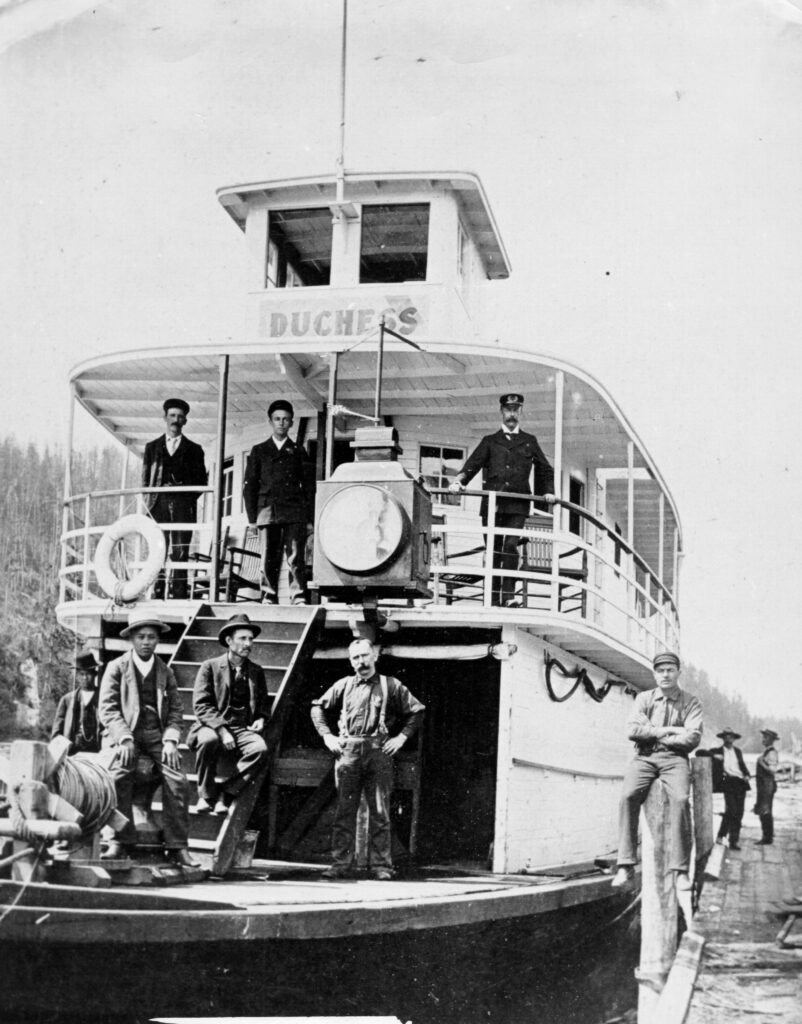The Duchess

The Golden Star – 11 Aug 1968 – Page 4
Steamboat Mail Service Recalled
The delivery service set up in various parts of Canada during the postal strike, brought to the mind of Ken Liddell, columnist for the Calgary Herald, a mail service operated along the Columbia River south of Golden by Capt. Armstrong in the days of the paddle-wheelers. Mr. Liddell wrote:
“…Upper Columbia Navigation and Tramway Company…in 1897 issued its own stamps.
The company was run by Captain Frank Armstrong, who had a few rather fantastic craft. Captain Armstrong tried to beat the government at its own game for what in those days would have been a good reason to any rugged individual.
“He was angry at the customers.”
Captain Armstrong was 20 years of age when he reached the Columbia Valley country from Quebec in 1882. He started organized navigation on the Columbia by launching the Duchess at Golden.
“It was a rather nondescript craft to have carried such a classy name. Armstrong built it with an idea more than plans. The timber that went into the vessel was of various sizes. The steam engine was second hand.”
“One sinking occurred at the head of Canyon Creek rapids. The old girl left the Columbia carrying a film of color, if you will pardon the play on words. She was carrying a supply of uniforms for the Mounties at Fort Steele when she went down. The Columbia has never seen such colorful driftage. “
Armstrong built tramways to navigate missing links in the water courses that are the Columbia and Kootenay Rivers and in time he was operating, although only briefly, from Golden clear to Jennings, Montana, some 300 miles.
“He called the outfit the Upper Columbia Navigation and Tramway Company and he got into the postal business, in every sense of the word, because a competing stage firm captured the mail subsidy and left Armstrong with a growing number of small debts. “
“The stage could not possibly serve all the settlers. Many lived near the river and depended upon the boats. Upon hearing the whistle of the Duchess, these folks would go t the landing and leave with the boats crew, letters to be mailed elsewhere.”
“Often, they would give a few pennies for the purser to pay for the postage, but just as often would not.”
“Like most small debts, these were forgotten by the settlers who cheerfully accepted the company’s good will. The debts, however, began to accumulate. Armstrong, not to mention the purser, found the whole thing increasingly annoying.”
“So, in 1897 the company printed 1,000 stamps of a five-cent denomination. These stamps were marked ‘U.C.Co. 5c in a wreath of red leaves.”
“The company had tow reasons for having the stamps printed. One was to discourage the free delivery service and the other to provide the purser with a check on what had been paid when he remailed the letters with government postage affixed. “
“Word of the stamps being in use reached Ottawa faster than the mail itself. Armstrong was warned to cease and desist.”
“So, Armstrong withdrew his stamps to avoid trouble.”
“Some cancelled letters that survived in albums of collectors and in old trunks in attics, show the stamps were in use from July 1888, to August 1899. Armstrong’s firm also cancelled the stamps, so the dates were on record.”
“The stamps became of great interest, and some value to collectors in later years. As recently as in 1951., Fred Eaton of the Stanley Stamp Company in Vancouver purchased one of the stamps at an auction in New York. It was on a n envelope dated Golden, July 27, 1898.”
